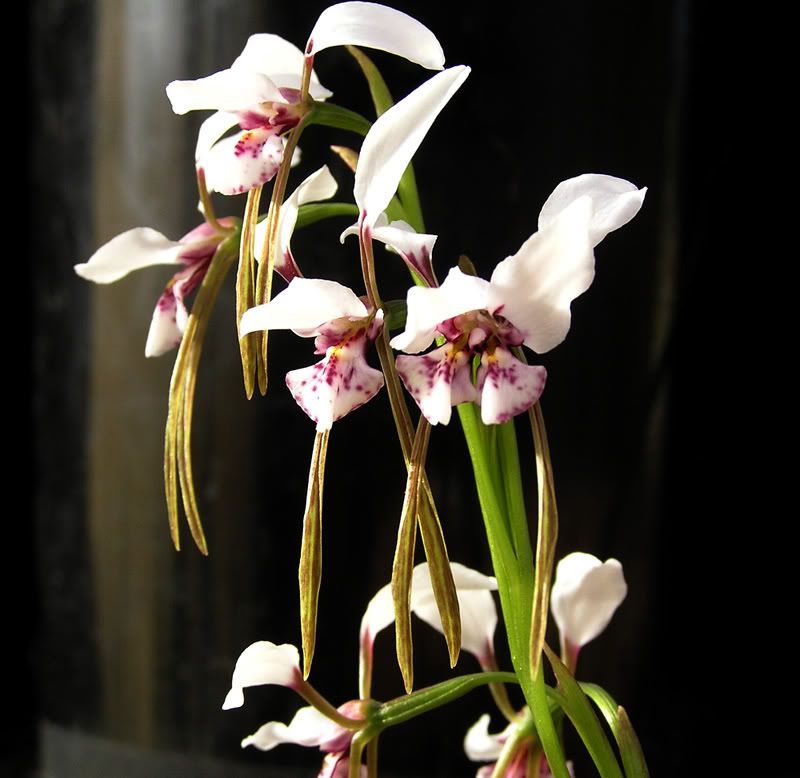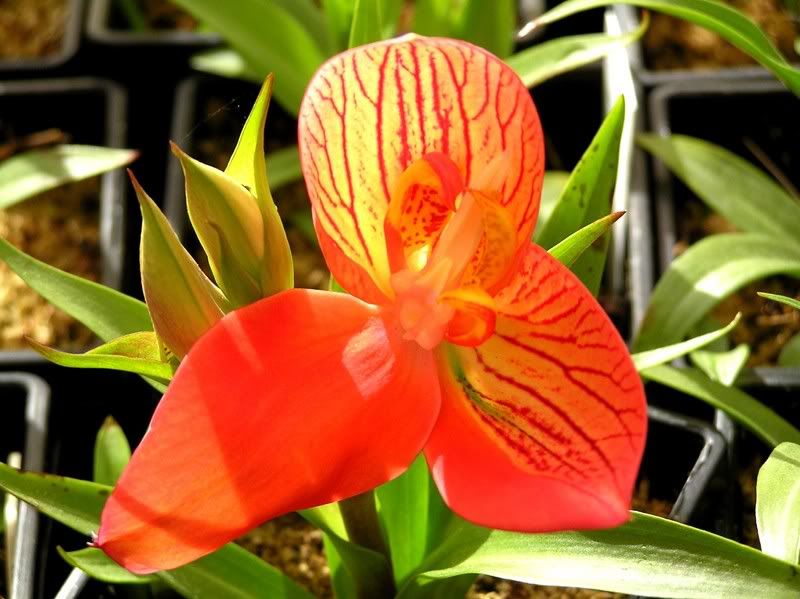


Donate Now
and become
Forum Supporter.

Many perks!
<...more...>


|

07-30-2009, 01:12 PM
|
|
Jr. Member
|
|
Join Date: Jul 2009
Zone: 7a
Location: Daytona Beach, FL, USA
Posts: 2
|
|
 Mutation---how common
Mutation---how common
I have a white paph that has only a large upper sepal, a much smaller lower sepal, and two petals--no labellum.
I thought that the first flower had been damaged in shipping. It has produced two more flowers and they are all the same. They are very attractive, but strange. The plant appears to be very healthy and robust. Is this a common or a rare mutation?
|

07-30-2009, 03:39 PM
|
|
Senior Member
|
|
Join Date: Jan 2008
Zone: 8a
Location: Piney Woods of East Texas
Age: 47
Posts: 3,253
|
|
I don't think it's that rare, but it's certainly not common either. Sometimes the first bloom on a plant can be crippled, but if they are all blooming the same I'd say it's a mutation.
One thing is for sure - you have to post a picture!  |

07-30-2009, 09:54 PM
|
|
Senior Member
|
|
Join Date: May 2007
Location: Victoria
Posts: 502
|
|

The term mutation seems to get thrown around a bit too loosely in reference to flowers that aren't doing what you'd expect. While I'm not ruling out the possibility of a mutation, environmental factors can play havoc on flower formation and occassionally, particularly in the case of hormones and pesticides, these effects can be maintained across several flowers on the spike and even across several spikes.
Two examples in my collection that I bothered to take a photo of:
This Diuris came out with 2 dorsal sepals and 2 labellums - no other flower was affected. Probably just a chance developmental malformation.

This Disa came out with 2 dorsal sepals, 1 lateral sepal, 3 petals and a small stub for a labellum. The plant had never flowered this way before or since and but all flowers on the spike were affected. I'm still wondering what caused it but I suspect it was related to using fungicides at the wrong time.

There is also a habit of many initially peloric orchids loosing their peloricism after a few years. Keep an eye on your plant over the next few years to see if the missing labellum returns before committing to it being a stable trait. However, I suspect the next spike or the one after that will probably bloom out fine.
Last edited by Andrew; 07-30-2009 at 09:57 PM..
|
|
Post Thanks / Like - 1 Likes
|
|
|
|
|

07-30-2009, 10:08 PM
|
|
Senior Member
|
|
Join Date: Apr 2009
Zone: 6b
Location: Rochester, NY
Age: 43
Posts: 456
|
|
FYI Andrew. Even if you used fungicides at the wrong time, it could definitely cause a mutation. The question I guess it, will that genetic mutation become permanent in the plants genes?
|

07-31-2009, 10:23 AM
|
|
Senior Member
|
|
Join Date: Jan 2008
Zone: 8a
Location: Piney Woods of East Texas
Age: 47
Posts: 3,253
|
|
Quote:
Originally Posted by Andrew

Probably just a chance developmental malformation.
|
How else would you define mutation? |

07-31-2009, 11:58 AM
|
|
Senior Member
|
|
Join Date: May 2007
Location: Victoria
Posts: 502
|
|

Quote:
Originally Posted by RoyalOrchids

How else would you define mutation?
|
The generally accepted biological meaning is a change to the nucleotide sequence of the DNA.
Certainly somatic mutations can result in aberrant floral development and I don't argue with PitcherASAMD that fungicides could potentially result in a mutation within the meristematic tissue in the developing spike which could be inherited by the cells in the flowers on that spike. My issue with the use of the word mutation is that it's often used when there is no direct evidence that a mutation has occurred. In addition to mutations, external stimuli could also unbalance transcription regulation or signal transduction regulation, or affect gene methylation or histone modification, which could also produce abnormal growth without modifying the gene sequence. For a somatic mutation to have affected the entire spike, wouldn't it need to have occurred within the meristematic cell that gave rise to the vast majority if not all cells in the flower? ie such a mutation would have a very small window of opportunity to affect multiple flowers. On the otherhand, environmental stimuli that affect the cell's biochemistry without affecting the gene sequence could affect vast numbers of cells within the spike tissue throughout the developmental period giving a greater likelihood of occurring. Adding to this, if multiple abnormal flowers on a spike invariably result from mutations in cells that give rise to the entire spike:
(a) why do these 'mutations' rarely get passed on through the seed/pollen? (if the mutation occurs early enough to affect the while spike, wouldn't it occur before the germ cells differentiate from the meristem),
and (b) if the spike's gene sequence has changed, why do subsequent flowers on the affected spike often revert back?

|

07-31-2009, 12:22 PM
|
|
Senior Member
|
|
Join Date: Apr 2007
Zone: 8b
Location: Southern Oregon
Age: 70
Posts: 6,016
|
|
So the short answer is mutation=the gene sequence of the entire plant has been somehow permanently altered. Malformation=localized cell development altered by some environmental factor, and not permanent.
|

07-31-2009, 04:46 PM
|
|
Senior Member
|
|
Join Date: Jan 2008
Zone: 8a
Location: Piney Woods of East Texas
Age: 47
Posts: 3,253
|
|

Quote:
Originally Posted by Andrew

The generally accepted biological meaning is a change to the nucleotide sequence of the DNA.
Certainly somatic mutations can result in aberrant floral development and I don't argue with PitcherASAMD that fungicides could potentially result in a mutation within the meristematic tissue in the developing spike which could be inherited by the cells in the flowers on that spike. My issue with the use of the word mutation is that it's often used when there is no direct evidence that a mutation has occurred. In addition to mutations, external stimuli could also unbalance transcription regulation or signal transduction regulation, or affect gene methylation or histone modification, which could also produce abnormal growth without modifying the gene sequence. For a somatic mutation to have affected the entire spike, wouldn't it need to have occurred within the meristematic cell that gave rise to the vast majority if not all cells in the flower? ie such a mutation would have a very small window of opportunity to affect multiple flowers. On the otherhand, environmental stimuli that affect the cell's biochemistry without affecting the gene sequence could affect vast numbers of cells within the spike tissue throughout the developmental period giving a greater likelihood of occurring. Adding to this, if multiple abnormal flowers on a spike invariably result from mutations in cells that give rise to the entire spike:
(a) why do these 'mutations' rarely get passed on through the seed/pollen? (if the mutation occurs early enough to affect the while spike, wouldn't it occur before the germ cells differentiate from the meristem),
and (b) if the spike's gene sequence has changed, why do subsequent flowers on the affected spike often revert back?
|
I guess I asked the right person.  I still want to see pics of this odd-ball.
As for inheritance, don't some mutations show up in progeny? Is peloria a mutation? Albinism? Dwarfism? While I understand that gene expression (or suppression) plays more of a role in some of these instances, the field of genetics for the most part is over my head. Must a mutation always involve a change in nucleotide sequence? What about doubling or deletion? I'm not too learned on this topic, please help me understand.

|

08-01-2009, 12:42 AM
|
|
Jr. Member
|
|
Join Date: Jul 2009
Zone: 7a
Location: Daytona Beach, FL, USA
Posts: 2
|
|
 My atypical orchid
My atypical orchid
Thank you for all the good comments. I was unaware that paphs are so sensitive to chemical exposure. The attached picture is of the first two blossoms. The plant has now produced another blossom that is the same as the two pictured.
|

08-01-2009, 01:17 AM
|
|
Senior Member
|
|
Join Date: Nov 2007
Zone: 3b
Location: Saskatoon, Saskatchewan
Age: 39
Posts: 992
|
|

Quote:
Originally Posted by RoyalOrchids

I guess I asked the right person.  I still want to see pics of this odd-ball.
As for inheritance, don't some mutations show up in progeny? Is peloria a mutation? Albinism? Dwarfism? While I understand that gene expression (or suppression) plays more of a role in some of these instances, the field of genetics for the most part is over my head. Must a mutation always involve a change in nucleotide sequence? What about doubling or deletion? I'm not too learned on this topic, please help me understand. |
Lets see if this makes some sense! 
To clarify - somatic mutations are mutations in the genetic code that don't get passed on to progeny (ie skin cells that mutate to become cancerous does not effect any children you may sire during the period) vs germ line mutations (ie mutations in sperm/egg cells which eventually divide and divide again thus passing on the mutation to all the cells of the progeny).
A mutation by definition is a change in nucleotide sequence, whether it is through deletions, insertions, translocations and the list goes on!
What Andrew was mentioning regarding changes in gene regulation or expression being mistaken for mutations is that sometimes chemicals or environmental factors can cause some genes to be suppressed, or expressed. Simple example - humans produce more melanin in response to sunlight (aka Tanning)....you've gotten darker in response to the sun, but you haven't mutated...you've just cranked up the 'activity' of the genes responsible for producing pigment.
To further complicate the picture, just because a plant has a mutant gene doesn't mean that it always looks mutated. This is partly because plants have more than one chromosome, which means more than one copy of each gene, which means even if one copy is mutated, the other copy might be working fine and mask any effects you see. Sometimes, you only see the effects of the mutated gene under stress or special conditions (ie weird chemical/fungicides?!)...an example is people who have one copy of the gene causing sickle celled anemia...their red blood cells are typically fine, but under conditions of low oxygen, their blood cells will turn sickle shaped, causing many problems like blocked arteries etc...In this case, only certain conditions cause the mutated phenotype to appear.
With that said, from my limited knowledge of plants (I work with humans), I believe pelorism and albinism is typically genetic in nature, although the way the phenotype (what you actually see) is expressed is probably quite complicated with many factors playing a role.

|
|
Currently Active Users Viewing This Thread: 1 (0 members and 1 guests)
|
|
|
 Posting Rules
Posting Rules
|
You may not post new threads
You may not post replies
You may not post attachments
You may not edit your posts
HTML code is Off
|
|
|
All times are GMT -4. The time now is 11:10 PM.
|





































 Linear Mode
Linear Mode


